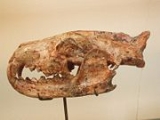
Hyaenodon
Overview
Hyaenodon is an extinct
genus
of Hyaenodonts
, a group of carnivorous
creodonts
of the family
Hyaenodontidae
endemic to all continents except South America
, Australia
and Antarctica, living from 42—15.9 mya, existing for approximately .
Some species
of this genus were amongst the largest terrestrial carnivorous
mammal
s of their time; others were only of the size of a marten
. Hyaenodon was one of the latest genera of the Hyaenodonts and is known from the Late Eocene to Early Miocene.
Extinction
In biology and ecology, extinction is the end of an organism or of a group of organisms , normally a species. The moment of extinction is generally considered to be the death of the last individual of the species, although the capacity to breed and recover may have been lost before this point...
genus
Genus
In biology, a genus is a low-level taxonomic rank used in the biological classification of living and fossil organisms, which is an example of definition by genus and differentia...
of Hyaenodonts
Hyaenodontidae
Hyaenodontidae is a family of the extinct order Creodonta, which contains several dozen genera.The Hyaenodontids were important mammalian predators that arose during the late Paleocene and persisted well into the Miocene...
, a group of carnivorous
Carnivore
A carnivore meaning 'meat eater' is an organism that derives its energy and nutrient requirements from a diet consisting mainly or exclusively of animal tissue, whether through predation or scavenging...
creodonts
Creodonta
The creodonts are an extinct order of mammals that lived from the Paleocene to the Miocene epochs. They shared a common ancestor with the Carnivora....
of the family
Family (biology)
In biological classification, family is* a taxonomic rank. Other well-known ranks are life, domain, kingdom, phylum, class, order, genus, and species, with family fitting between order and genus. As for the other well-known ranks, there is the option of an immediately lower rank, indicated by the...
Hyaenodontidae
Hyaenodontidae
Hyaenodontidae is a family of the extinct order Creodonta, which contains several dozen genera.The Hyaenodontids were important mammalian predators that arose during the late Paleocene and persisted well into the Miocene...
endemic to all continents except South America
South America
South America is a continent situated in the Western Hemisphere, mostly in the Southern Hemisphere, with a relatively small portion in the Northern Hemisphere. The continent is also considered a subcontinent of the Americas. It is bordered on the west by the Pacific Ocean and on the north and east...
, Australia
Australia
Australia , officially the Commonwealth of Australia, is a country in the Southern Hemisphere comprising the mainland of the Australian continent, the island of Tasmania, and numerous smaller islands in the Indian and Pacific Oceans. It is the world's sixth-largest country by total area...
and Antarctica, living from 42—15.9 mya, existing for approximately .
Some species
Species
In biology, a species is one of the basic units of biological classification and a taxonomic rank. A species is often defined as a group of organisms capable of interbreeding and producing fertile offspring. While in many cases this definition is adequate, more precise or differing measures are...
of this genus were amongst the largest terrestrial carnivorous
Carnivore
A carnivore meaning 'meat eater' is an organism that derives its energy and nutrient requirements from a diet consisting mainly or exclusively of animal tissue, whether through predation or scavenging...
mammal
Mammal
Mammals are members of a class of air-breathing vertebrate animals characterised by the possession of endothermy, hair, three middle ear bones, and mammary glands functional in mothers with young...
s of their time; others were only of the size of a marten
Marten
The martens constitute the genus Martes within the subfamily Mustelinae, in family Mustelidae.-Description:Martens are slender, agile animals, adapted to living in taigas, and are found in coniferous and northern deciduous forests across the northern hemisphere. They have bushy tails, and large...
. Hyaenodon was one of the latest genera of the Hyaenodonts and is known from the Late Eocene to Early Miocene.

